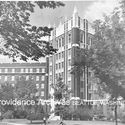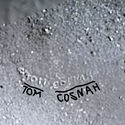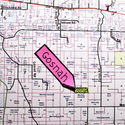"Rock writer" on the prairie: The rest of the story
December 23, 2020
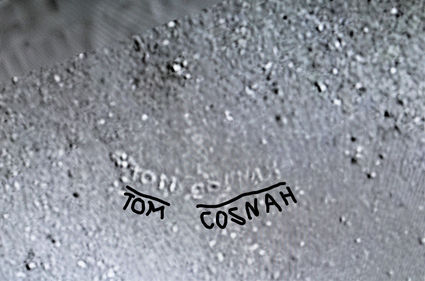
The rock writing of the name "Tom Cosnah" is large enough to be seen on this image from the Google Earth mapping satellite. Research identified Thomas Gosnah as a homesteader in the Paradise Valley east of Chinook who likely did the rock writing. It's not clear if the original letter "G" was purposefully modified to look like the letter "C" or if the disturbance was inadvertent.
Alert readers may recall a story that ran in the October 7, 2020 issue of the "Journal" about some unusual "rock writings." On the family ranch south of Chinook, Mark Burkhartsmeyer found a hilltop with several sets of initials fashioned with random stones. Of particular interest was a complete first and last name spelled out with stones about the size of footballs. As best could be determined the name laid out with stones was "Tom Cosnah."
Mark asked me if I would be interested in doing a story about the unusual 'rock writings.' I asked Mark what he would like to know and he said, "I would like to learn about Tom Cosnah-where he was from, when he was in this area, what his history was and where he ended up." After my initial request to readers yielded no responses about Tom Cosnah, I dug into his history. With the help by folks from Chinook to Seattle, here's some of what I learned about the "rock writer."
Right guy, wrong name...
Kadie Dahl, from Chinook, did some searches of census and other records for me. She concluded, "I never could find Thomas Cosnah but I did find Thomas Gosnah in the 1910 census." Gosnah was born in Germany in 1871, immigrated to the U.S. in 1909 and homesteaded in the Paradise Valley. Mark Burkhartsmeyer's first thought was perhaps the census taker mistook the "G" in the name for a "C" noting, "In German both letters have hard sounds." Subsequent discoveries showed a Thomas Gosnah did live in the area and likely laid out the rocks to spell his name. Removing a few rocks that formed the cross piece on a "G" would yield a "C" but if or why that happened is unclear.
Gosnah received a patent in 1914 on a 320 acre homestead in the valley (see photo with arrow for location). Under the homestead act that applied he had to live on the property for at least five years. That would mean at a minimum he lived in the valley in as early as 1909, if the residency rule was strictly enforced.
Mark Burkhartsmeyer said the hilltop where the rock writings were found was once part of the Miller Brothers, Inc. operation. That suggested Gosnah might have been a sheepherder/laborer for the Millers. An archivist at the Montana Historical Society did a search of the "six linear feet of records" at the Society for the Miller Brothers and reported, "I was unable to locate Mr. Gosnah's name anywhere in them [records] and yes, I looked under the various spellings of his name." But did that prove Gosnah was not an employee of the Millers? Maybe there was no written agreement, back then a handshake often sealed the deal for short term employment.
From 1917-1931 the area near Gosnah's homestead was mined for coal. Burkhartsmeyer wondered if perhaps Gosnah was mining coal, on a smaller scale, and selling/hauling it to ranchers and farmers in the area. Gosnah sold the homestead in 1915 and eventually ended up in Great Falls.
On to the Judith Basin and finally to the Columbus Hospital in Great Falls
Gosnah's first stop after leaving the homestead was the Judith Basin area. I spoke to the librarian in Stanford, the county seat, but she could find no documents about Gosnah's time there. From his death notice in the "Great Falls Tribune" I learned he had a work injury while in that area and "lived in the Judith Basin area until 1920." In later documents (death certificate) his work injury was described as a "hip injury" and apparently prevented him from doing work he was doing.
In a set of diary-like chronicles kept by the Sisters of Providence at the Columbus Hospital in Great Falls, during the period of Summer, 1919-Spring, 1921, "Thomas Gasnak from Choteau, Montana, asked to be admitted for the rest of his life. He wanted to give the sisters all he had, $4100 (just under $60,000 in today's dollars) and furniture too. It was accepted." A possible explanation of the name spelling is this: when first recorded the chronicles were written in French; Gosnah probably still had a heavy German accent and the sisters heard/wrote "Gasnak" and eventually the French was translated to English and a variation of the spelling of the name. Subsequent documents about Gosnah coordinate with this timing for his arrival at the hospital, where he was accepted as a "boarder."
During that era there were many mentions of people without family or wherewithal who came to the hospital, basically, to die. An archivist for the Providence Archives in Seattle explained the idea of "boarders" at Providence hospitals in the late 1800's and early 1900's noting, "Sometimes it may have been room and board provided in exchange for odd jobs around the hospital, or for a monthly fee." She added that mention of boarders occasionally surfaces in records but she believes, "Social Security and other government safety net programs may have changed the landscape." Gosnah's death notice and death certificate both indicate he did odd jobs at the hospital and apparently, in exchange, the hospital staff cared for him.
In 1928 Gosnah was listed in the Great Falls City Directory with an address shown as the parking lot for the old Columbus Hospital (1601 2nd Avenue North. Cascade County bought that building in 1978 and converted it into a business center). The archivist in Seattle found a couple of references to Gosnah: in 1943 as "an elderly boarder." In 1956 he was listed as a sponsor at another person's baptism and described as being "a cripple" and "over 70 years old."
It appears Gosnah did have duties at the hospital. In his death notice he was listed as "employed as an elevator operator at the hospital" and "known to many patients to whom he sold newspapers in his later years." His death certificate listed his occupation as "custodian." He never had a Social Security number which suggests he was never officially employed at the hospital. Interestingly, he never showed up in any census after 1910-likely census takers didn't canvas for boarders in hospitals.
Gosnah died at age 93 in 1964, four decades after becoming a boarder at the hospital. Officially arteriosclerosis gave rise to the cause of his death: "senility." His funeral was held at St. Ann's Cathedral and he is buried at Olivet Cemetery. Gosnah never married and had no known relatives at the time of his death.
One significant question remains: why the rock writing?
Mark Burkhartsmeyer has two theories that might explain the location of the rock writing. If Gosnah tended sheep for the Miller Brothers, sheepherders were known for the "monument's" they built-rocks piled for practical purposes or as a distraction from a lonely job. He said hilltops were chosen because, "livestock would be less prone to disturb monuments atop a hill" and "from a hilltop the shepherds could keep an eye on their animals." Mark believes it was likely a resting/meeting place for sheepherders and that explains the number of other initials, rock piles and Gosnah's spelled out name.
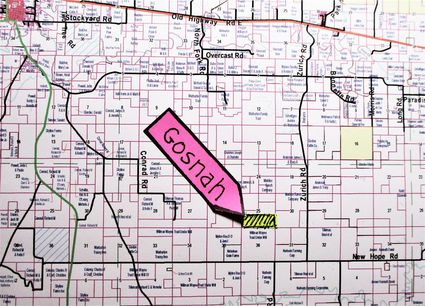
The arrow shows the location of the 320-acre homestead patented by Thomas Gosnah in 1914 (Chinook is in the upper left hand corner of the photo). He sold the homestead in 1915 and moved to the Judith Basin area. This homestead later was part of the Hebbelman Mine where coal was extracted from 1917-1931. The hilltop where Gosnah laid out his name, with football-sized rocks, is about 20 miles south of his original homestead.
Burkhartsmeyer also speculates that since the hilltop with the rock writing is near the old road that ran south to the Bear Paws, it might have been a stop for freighters resting their teams or even spending the night. If Gosnah was hauling coal he might have stopped on more than one occasion at the hilltop. (The layout of his name suggests it was done at on at least two separate occasions). Why the rock writing was done and why at that location at that location are still remaining questions.



